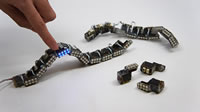The Art of Building a Robot
Sensors and gripper arms can simply be attached and removed as needed. You dont even have to be a specialist to quickly and easily replace a defective part, which makes the robots extremely flexible and economical to operate.
MIT's Modular Robotic Chain Is Whatever You Want It to Be
Evan Ackerman for IEEE Spectrum: As sensors, computers, actuators, and batteries decrease in size and increase in efficiency, it becomes possible to make robots much smaller without sacrificing a whole lot of capability. There’s a lower limit on usefulness, however, if you’re making a robot that needs to interact with humans or human-scale objects. You can continue to leverage shrinking components if you make robots that are modular: in other words, big robots that are made up of lots of little robots.
In some ways, it’s more complicated to do this, because if one robot is complicated, robots tend to be complicated. If you can get all of the communication and coordination figured out, though, a modular system offers tons of advantages: robots that come in any size you want, any configuration you want, and that are exceptionally easy to repair and reconfigure on the fly.
MIT’s ChainFORM is an interesting take on this idea: it’s an evolution of last year’s LineFORM multifunctional snake robot that introduces modularity to the system, letting you tear of a strip of exactly how much robot you need, and then reconfigure it to do all kinds of things. Cont'd...
RENCO Modular Rotary Encoders Ideal for Mobile Robots
The RENCO encoders slim and lightweight design allows motor designers more flexibility, especially in these applications where space and weight is critical.
Echoing Government's Productivity 4.0, IoT Automation Boosts Taiwan's Competitiveness
Facing challenges of labor shortages and aging labor forces, Taiwan's Ministry of Economic Affairs is implementing "Productivity 4.0" to stimulate economic growth and upgrade industries.
Records 1 to 4 of 4
Featured Product

ResinDek® TRIGARD® ESD ULTRA FOR HIGH-TRAFFIC ROBOTIC APPLICATIONS
To maximize the productivity of an autonomous mobile robot (AMR) or automatic guided vehicle (AGV) deployment, it's critical to create the optimal environment that allows the vehicles to perform at their peak. For that reason, Cornerstone Specialty Wood Products, LLC® (www.resindek.com) created the TriGard® ESD Ultra finish for its ResinDek® engineered flooring panels. The TriGard ESD Ultra finish is ideal for high-traffic robotic applications characterized by highly repetitive movement patterns and defined travel paths.

.jpg)

